Looking for the best ecommerce website builders for your small business?
You’re in the right place.
With global retail e-commerce sales hitting $4.921 trillion in 2021, it’s no surprise that businesses small and large want a piece of the ecommerce pie.
As the industry has grown, tech companies and startups have expanded their offerings to meet the surge in demand. This means that new entrepreneurs and business vets alike have a large variety of ecommerce website building tools to choose from. This wealth of offerings is beneficial for those in the ecommerce space, but so many options can make finding the right platform for your business a bit overwhelming.
To help aid you in your search, we’ve compiled a list of the 8 best ecommerce site builders on the market. All the tools we’ve selected are good options, but each one has its own strengths and weaknesses that will make it a better fit for different types of users.
By the end of this guide, you’ll have a clear idea of what the best ecommerce platforms are, their pros and cons, their costs, and what the best fit for you is.
If you don’t want to learn all the ins and outs of e-commerce website builders and simply want to know our top picks, we’ve placed the comparison of features overview chart right below to save you some time. But if you want to get a more in-depth look, keep reading for our detailed analysis.
Best for Artists: BigCartel
BigCartel may not have the extensive feature set of many of its competitors, but it’s the most focused website builder out of all the ones we’ve looked into. The entire platform is tailored to artists and makers, and is incredibly easy to get a store up and running with very little effort.
It’s fairly restrictive in its product limits (the most expensive plan limits users to 500 products), but considering that it’s primarily geared towards people who want to monetize their art and not people who want to become ecommerce whizzes, that flaw can be overlooked.
Best for SEO: 3DCart
3DCart is hands-down the most complex website builder we’ve looked at. While that makes it a bad choice for most beginners, it offers a lot of features that established businesses looking to improve their rankings and optimize their sites will drool over. If improving SEO is your priority, then 3DCart should be at the top of your list.
Best for Beginners: Shopify
Shopify is one of the leading ecommerce platforms for a reason: it’s powerful and easy to use. New users can have a site up within minutes. However, unlike some of its competitors, such as BigCartel, this ease of use doesn’t sacrifice functionality. Shopify is used by small businesses and huge enterprises alike, so the platform will give you room to grow into its more advanced features.
Overview
Before getting into our in-depth reviews, here’s a quick comparison overview of the website builders we’ll be covering:
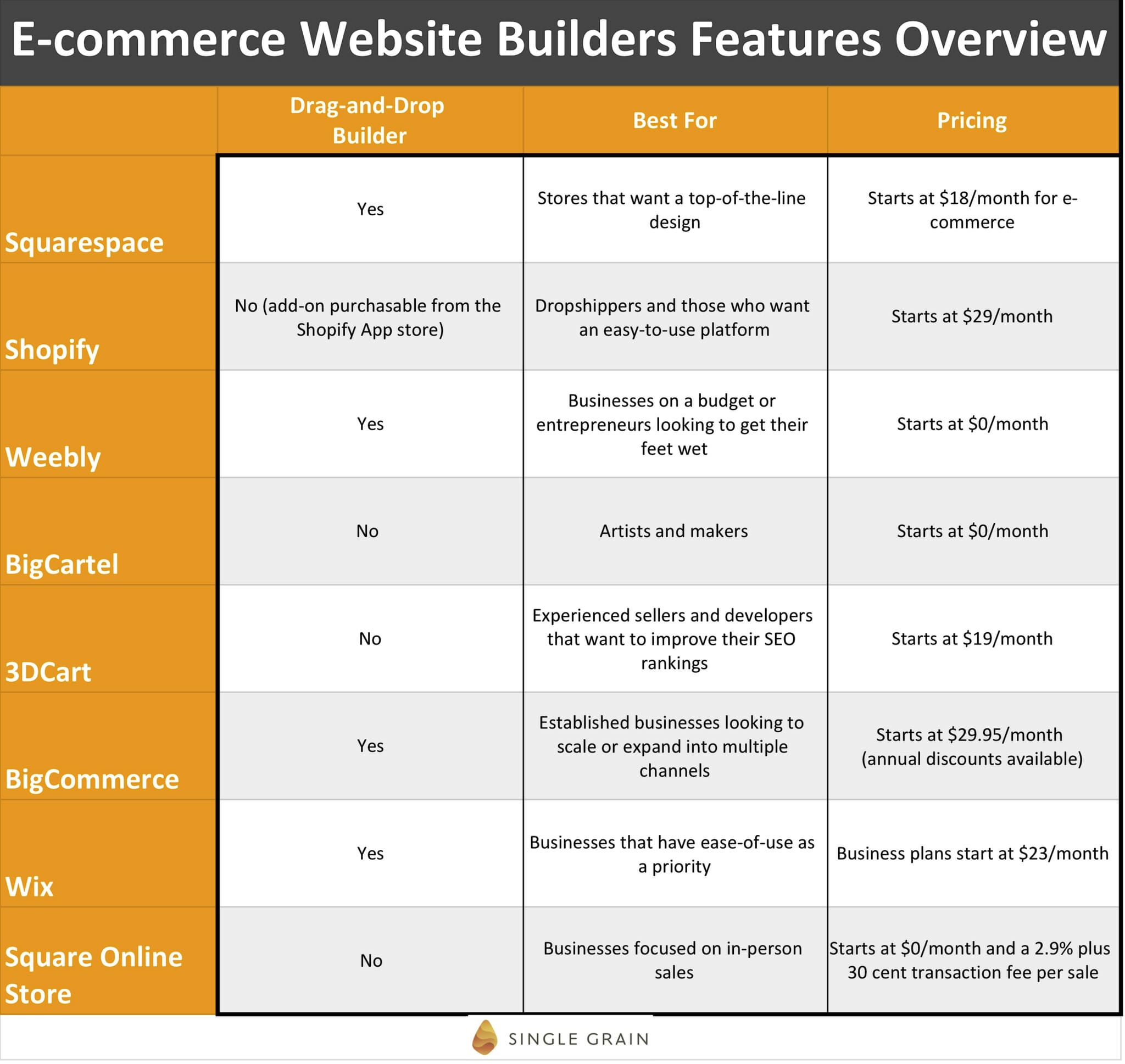
You may also like:
- 5 E-commerce Trends You Can’t Ignore in 2023
- Your E-commerce Sales Chore Chart for a Profitable 2020
- SEO for E-commerce Sites (Beginner & Intermediate)
- How to Set Up Your E-commerce Product Page for Maximum Conversions
8 Absolute Best E-commerce Website Builders
1) Squarespace
Squarespace Highlights:
* Website
* Pricing: Starts at $18/month for e-commerce
* Drag-and-Drop Builder: Yes
* Best For: Stores that want top-of-the-line design
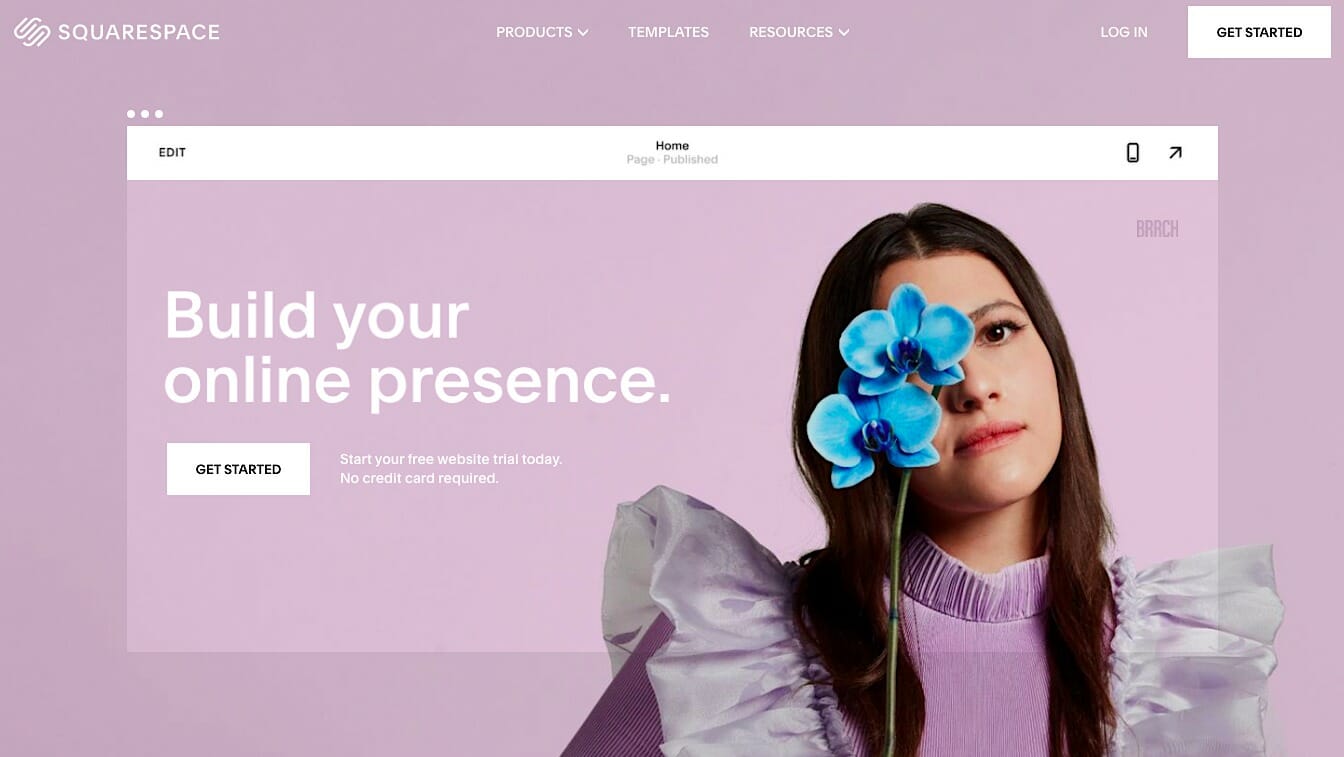
Squarespace is one of the biggest names in the website-building space. Founded in 2004, the company has become something of a household name over the past 16 years. While it wasn’t originally started with a focus on ecommerce, it has slowly but surely expanded its feature base to make it a formidable option.
Currently, Squarespace is the second-largest ecommerce platform after WooCommerce in terms of market share (20.22%). Considering that WooCommerce is a WordPress plugin and not a website builder, this means that Squarespace is actually the most popular ecommerce website builder, so they must be doing something right.
Squarespace shines when it comes to creating aesthetically pleasing websites. In short: Their templates are top-notch and users can easily build stunning websites without any web design experience. Plus, Squarespace has specific templates for online stores, some of which have won awards.
While Squarespace offers four different plans, you’ll need to subscribe to Business or higher if you want to sell online. That means you’ll be paying at least $18/month to get started. Or, if you find yourself needing the added features of some of the higher plans, you’ll be paying up to $40/month.
For example, while the Business plan lets you sell products online, you’ll need to sign up for the Basic Commerce plan ($26/month) if you’d like your customers to have their own accounts, and you’ll need to sign up for the Advanced Commerce plan ($40/month) if you’d like to sell subscriptions.
Most ecommerce businesses will want to start out with the Basic Commerce plan at the very least, but there’s no harm in signing up for Business first and upgrading later. The advanced analytics, merchandising tools, and on-domain checkout make it a worthwhile upgrade for most.
- Business: $18/month
- Basic Commerce: $26/month
- Advanced Commerce: $40/month
2) Shopify
Shopify Highlights:
* Website
* Pricing: Starts at $29/month
* Drag-and-Drop Builder: No (add-on available for purchase from Shopify store)
* Best For: Drop-shippers and those who want an easy-to-use platform

Like Squarespace, Shopify is also one of the biggest names in ecommerce. However, Shopify has made more of a name for itself in function than in form: Although its templates will get the job done, its focus simply isn’t on the packaging.
Instead, Shopify is known as an innovator in the functionality of ecommerce websites. More precisely, it has made the process of creating a store and maintaining it incredibly easy. Sellers can have stores up and running on Shopify in just 10 minutes.
The platform largely rose to fame during the rise of drop-shipping due to its integrations with Oberlo and print-on-demand platforms like Canva. If you’re interested in creating a drop-shipping store, Shopify is still one of the best choices thanks to its quick and easy set-up process as well as its integrations.
However, that ease of use comes with some drawbacks. For example, Shopify does not offer a drag-and-drop website builder. Although you can add that functionality with third-party apps like Buildify, it’s not built into Shopify and will cost you extra (Buildify is currently priced at $12.99/month). Shopify’s native design UI is much more akin to WordPress — you adjust parameters in a side pane, not directly on the site, like on Squarespace.
Luckily, Shopify comes with an expansive Shopify App platform where third-party developers offer apps and plug-ins that build on Shopify’s foundation. So even when Shopify doesn’t offer something (like a drag-and-drop builder), you can usually find an app that does the trick.
Shopify is a bit pricier than other platforms. Most users will be fine with Basic Shopify, but upgrading to the higher plans will get you enhanced reporting, more staff accounts, and lower rates and fees for credit cards and payment processing as well as better shipping discounts.
- Basic Shopify: $29/month
- Shopify: $79/month
- Advanced Shopify: $299/month
3) Weebly
Weebly Highlights:
* Website
* Pricing: Starts at $0/month
* Drag-and-Drop Builder: Yes
* Best For: Businesses on a budget or entrepreneurs looking to get their feet wet
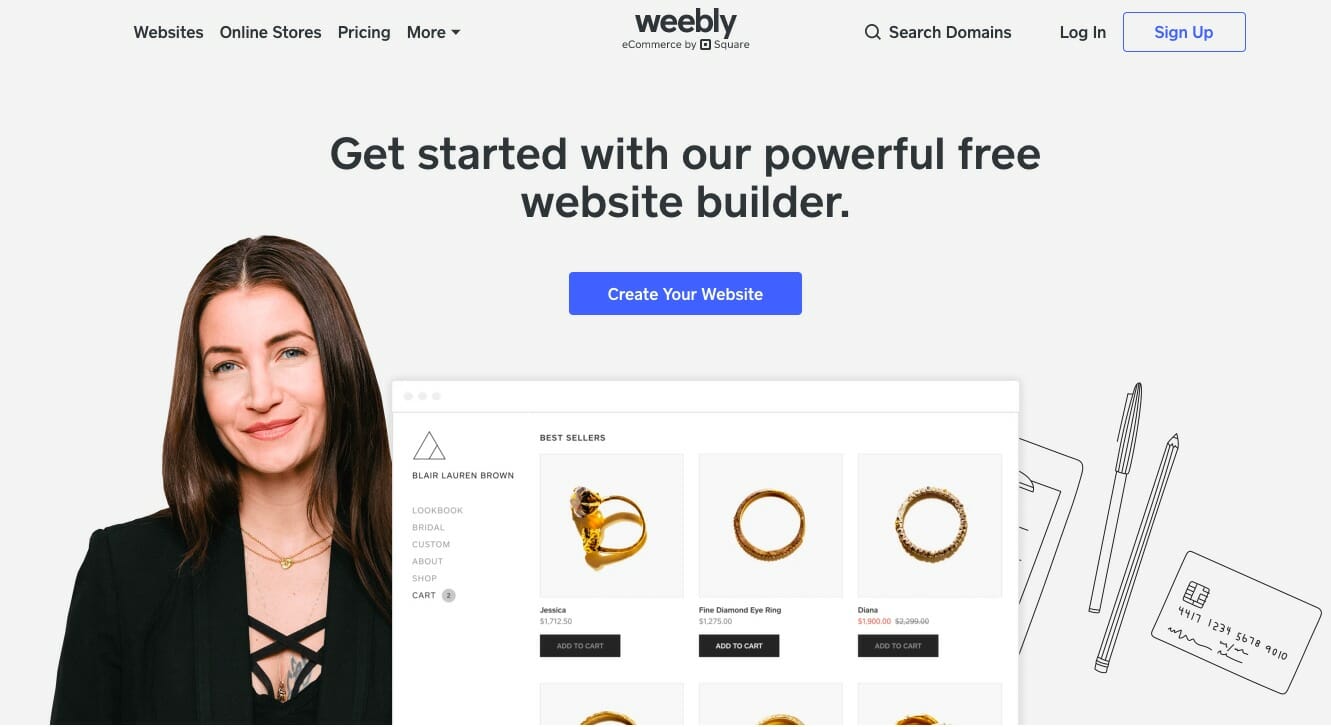
Weebly advertises itself as a free website builder. While many SaaS companies offer free plans that are severely watered-down versions of the real thing, Weebly is one of the few that offers a pretty full-featured platform for the price of $0/month.
Indeed, Weebly’s free plan provides most of the features that an ecommerce store would make use of, such as a shopping cart, inventory management, in-store pickup, coupons, etc. In fact, upgrading to the Performance plan, which is the most expensive plan at $26/month, only adds in reviews, the ability to receive payments through PayPal, shipping labels, and abandoned cart emails. Everything else you’d need to run a basic store is available in the free version.
The biggest difference between the free and paid versions is branding. With the free version of Weebly, you can’t use your own domain, and there will be ads for Square (which Weebly is powered by) on your site. While these may seem like small issues, having a branded domain and keeping your site free of ads can do a lot to instill trust and appear professional.
Since Weebly is powered by Square, it’s a great option for stores that are already accepting payment via Square. This makes it easy to accept both POS transactions and online transactions without issue.
So what’s the experience of actually building your site with Weebly like? Well, Weebly offers a drag-and-drop website builder, so it’s comparable to designing a site with Squarespace or any other drag-and-drop builder. In fact, some users may find Weebly even easier to use than Squarespace, which, combined with its free plan, makes it a perfect choice for those who are new to ecommerce and web development and want to wade into these waters slowly.
Since Weebly offers so much for free, most new ecommerce businesses will find it worth giving it a try, even if just to experiment a bit before moving on to another platform.
- Free: $0/month
- Personal: $6/month
- Professional: $12/month
- Performance: $26/month
4) BigCartel
BigCartel Highlights:
* Website
* Pricing: Starts at $0/month
* Drag-and-Drop Builder: No
* Best For: Businesses on a budget or entrepreneurs looking to get their feet wet
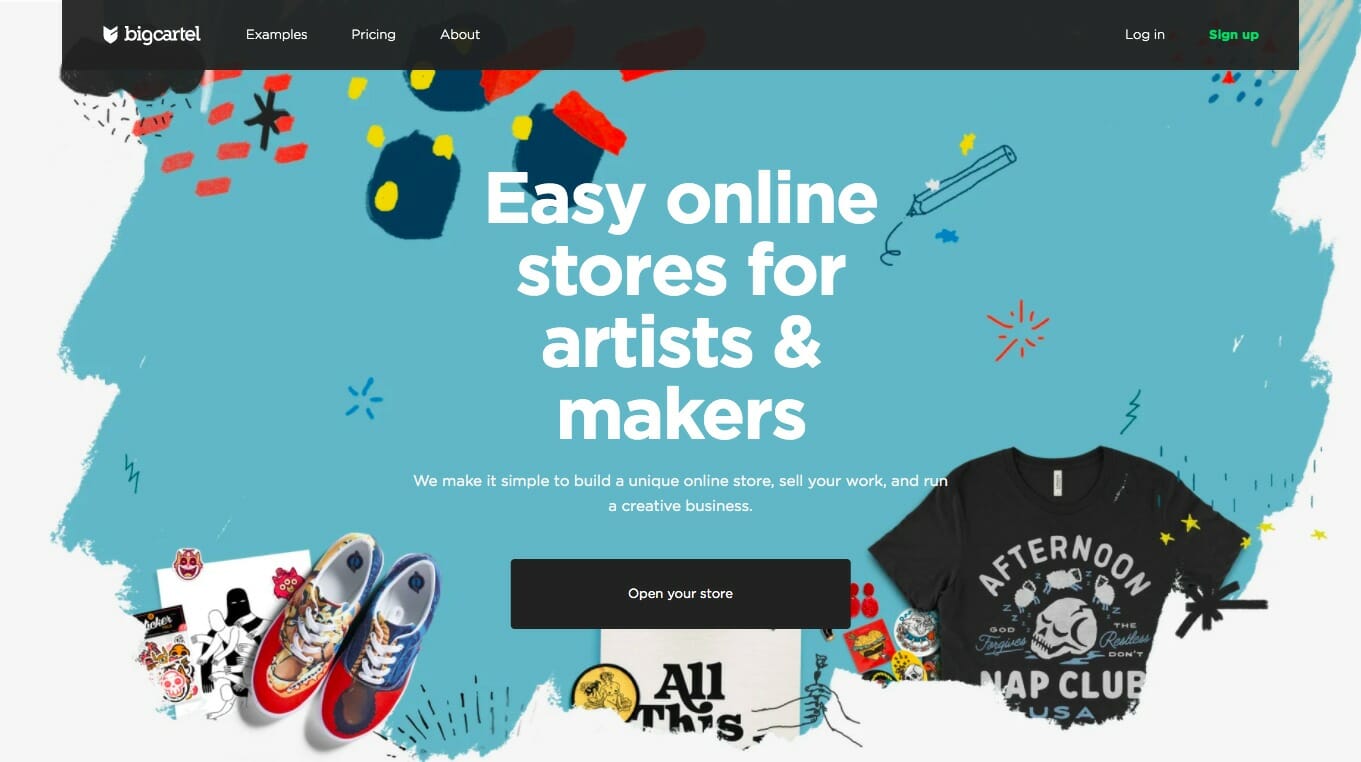
Like Weebly, BigCartel offers a free ecommerce plan, making it one of only two on this list to do so. However, BigCartel’s free plan only allows you to sell up to five products, whereas Weebly’s free plan allows sellers to list an unlimited number products.
Because of this, most stores will likely find BigCartel’s free plan too limiting and will want to move up to one of the paid plans. Luckily, these are still quite inexpensive compared to the rest of the market, so they will serve budget-conscious sellers well. The cheapest paid plan starts at $9.99/month and the most expensive is $29.99/month. For comparison, BigCartel’s pricing ends where Shopfiy’s begins.
However, even the paid plans are somewhat limiting. Though many ecommerce platforms allow sellers to list unlimited products, BigCartel’s most expensive plan caps users out at 500 products.
So who is BigCartel best for? The platform is marketed as an easy website builder for artists and makers. Given these restrictions, that makes sense. BigCartel doesn’t seem to be geared towards high-volume stores selling thousands of products each day. Instead, it was designed with freelance artists, photographers, potters, and fashion designers in mind, many of whom are selling handmade pieces and don’t need unlimited product listings. The platform prides itself on helping creators get out there and start making a living from their passions.
Good intentions aside, BigCartel lacks a lot of the features that you’d expect from an ecommerce platform. It doesn’t have a drag-and-drop website builder, which greatly limits site customizability, and it doesn’t have the advanced ecommerce features of Shopify to make up for that.
Overall, BigCartel can be a good choice for those who are selling only a few products and want a very cheap plan or artists and makers who simply don’t want to deal with the hassle of setting up a website. It lets you get up and running quickly and for very little money, but it doesn’t offer much else.
- Gold (5 products): $0/month
- Platinum (50 products): $9.99/month
- Diamond (250 products): $19.99/month
- Titanium (500 products): $29.99/month
5) 3DCart
3DCart Highlights:
* Website
* Pricing: Starts at $19/month
* Drag-and-Drop Builder: No
* Best For: Experienced sellers and developers that want to improve their SEO ranking
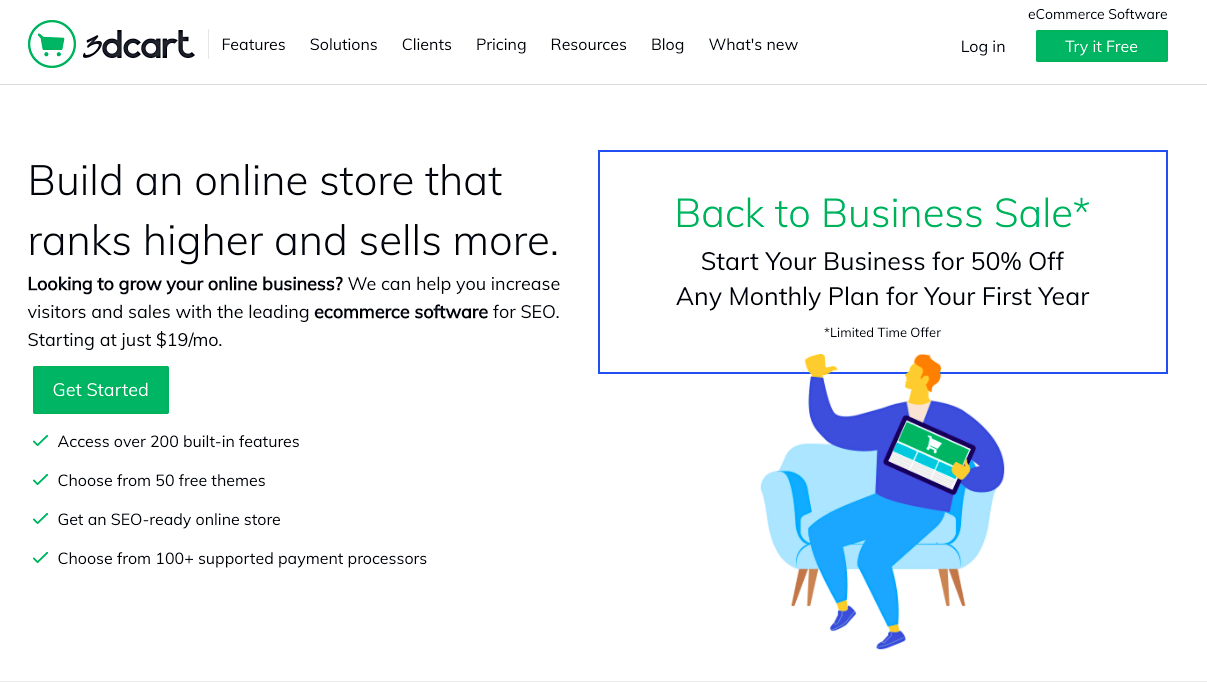
While the previous tool on this list focuses on ecommerce newbies, 3DCart goes in the complete opposite direction and directs its services primarily towards experienced sellers who are looking either to optimize their existing stores or create an entirely new one with a level of control that the other platforms we’ve looked at don’t offer.
Taking a quick look through 3DCart’s features, you’ll know pretty soon whether it’s a good choice for you. For example, if you know what image ALT tags, Google AMP, breadcrumb links, and 301 redirects with 404 auto-detection are, then 3DCart may be a good choice for you. But if this small sampling of features sounds like gibberish to you, then you’re better off starting out with something that’s geared towards beginners and intermediates.
3DCart excels when it comes to SEO, and the company proudly advertises that it was picked as “Best for SEO” by PCMag. The sheer number of features that 3DCart offers for SEO and marketing is impressive and includes everything from a built-in blog, email marketing service, and landing pages, to a slew of technical goodies like dynamic XML site mapping, PageSpeed optimization, and more.
As you might expect, 3DCart offers a lot of flexibility when it comes to setting up your site, but it won’t be as easy as using a platform like BigCartel, Squarespace or Shopify. However, what 3DCart lacks in intuitiveness it makes up for in optimization, providing several features that will help your sites load faster.
Pricing is very on-brand for 3DCart, with five different plans (the most we’ve seen) and a huge amount of variety between them. The cheapest plan is $19.00/month, and the most expensive is $229.00/month. You will need to look through the extensive feature comparison chart at the top of this post to figure out what’s right for you.
Overall, 3DCart is a very powerful platform, but it’s best suited for experienced developers and sellers. Ambitious beginners may also find the platform enjoyable, but getting a handle on the technical subtleties may not be the best use of time and energy for someone who is starting their first store or making their first endeavor into ecommerce.
- Startup Store: $9.50/month
- Basic Store: $14.50/month
- Plus Store: $39.50/month
- Power Store: $64.50/month
- Pro Store: $114.50/month
6) BigCommerce
BigCommerce Highlights:
* Website
* Pricing: Starts at $29.95/month
* Drag-and-Drop Builder: Yes
* Best For: Established businesses looking to scale or expand into multiple channels
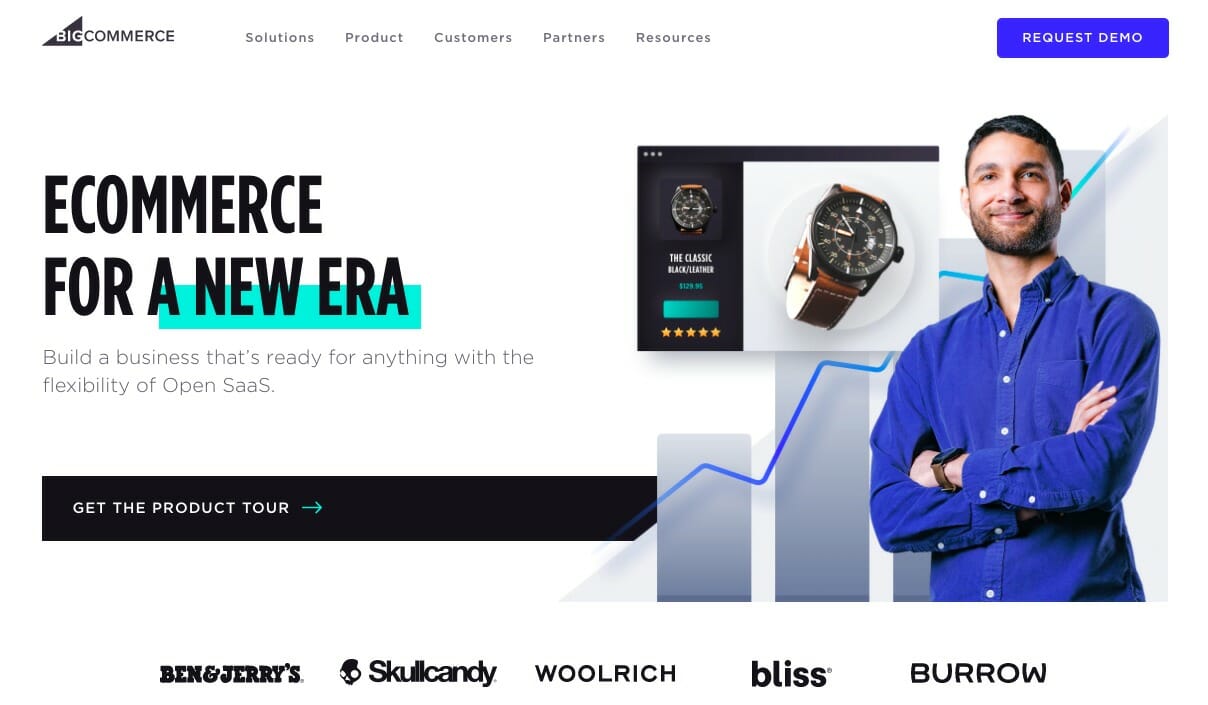
Like 3DCart, BigCommerce is geared a bit more towards advanced users, although not to the same extent that 3DCart is. While ecommerce newbies may find the platform a bit more complex than Squarespace or Shopify, they won’t be drowning in the deep end in the same way they would with 3DCart.
BigCommerce’s main selling point is somewhat evident from its name: It focuses more on big commerce than its competitors. It’s one of the few platforms that offers B2B selling features like bulk pricing, customer groups and quote management. It also puts great emphasis on selling across several different sales channels and comes with features that allow sellers to list their products on Amazon, Facebook, Pinterest, Instagram, Google Shopping, POS and eBay.
Given its name, its extensive feature list, and its focus on multi-channel sales, BigCommerce is clearly designed for established businesses that want to grow and expand into new sales channels. Some of its customers include Ben & Jerry’s, Woolrich, and Skullcandy. Of course, inexperienced store owners may find themselves at home with the platform as well, but fledgling entrepreneurs don’t appear to be BigCommerce’s raison d’etre.
From a design perspective, BigCommerce offers a lot of customizability. Businesses can make use of the drag-and-drop builder or edit the HTML, CSS and Javascript of one of the many provided templates. If you have experience with WordPress, you can also build your site entirely with WP while still using BigCommerce’s features.
BigCommerce also offers a bunch of optimization features for SEO and page load times. For example, you can make use of robots.txt editing, Google AMP, and Akamai Image Manager. Additionally, it allows for multiple currencies, simplifies cross-border fulfillment, and offers a global CDN for faster load times.
Price-wise, BigCommerce offers four plans starting at $29.95/month and reaching up to $299.95/month (discounts are available for annual subscriptions). There’s also an enterprise-level plan, but you’ll need to contact sales for custom pricing if you’re interested in that.
- Standard: $29.95/month
- Plus: $79.95/month
- Pro: $299.95/month
- Enterprise: Call for custom pricing
7) Wix
Wix Highlights:
* Website
* Pricing: Starts at $23/month
* Drag-and-Drop Builder: Yes
* Best For: Businesses that have ease-of-use as a priority

Wix is by far one of the best ecommerce solutions available. It’s able to combine the design strengths of Squarespace with the SEO features of platforms like BigCommerce and still manages to maintain the intuitive functionality of Shopify and similar platforms.
One of its best features is that it’s entirely commission-free. While many sites take a percentage of every sale, Wix steers clear of this, so you can take every dollar of profit from your sales.
While Wix offers a lot of features that are great for ecommerce, the platform wasn’t designed with sellers in mind. Primarily, Wix is marketed as a website builder, which means it can be used for anything from personal sites to ecommerce stores and everything in between. However, this means that Wix is less tailored to ecommerce than other platforms that are built from the ground up around selling your products online. Although this doesn’t negatively affect the experience, it is worth keeping in mind.
Wix includes a drag-and-drop website builder along with over 500 templates that you can use right away that are all optimized for mobile. Additionally, it offers blogging features and SEO tools.
A couple of standout features from Wix include a logo maker and an AI website designer called ADI (Artificial Design Intelligence), which generates websites based on a small selection of inputs.
Wix’s pricing is quite reasonable compared to its competitors. Its business plans start at $23/month and go up to $500/month for its top-of-the-line Enterprise plan.
Overall, Wix is a great choice for anyone looking to break into the ecommerce space. However, those who are already established will likely find a better friend in 3DCart or BigCommerce.
- Business Basic: $23/month
- Business Unlimited: $27/month
- Business VIP: $49/month
- Enterprise: $500/month
8) Square Online Store
Square Online Store Highlights:
* Website
* Pricing: Starts at $0/month + 2.9% + 30 cent transaction fee per sale
* Drag-and-Drop Builder: No
* Best For: Businesses focused on in-person sales
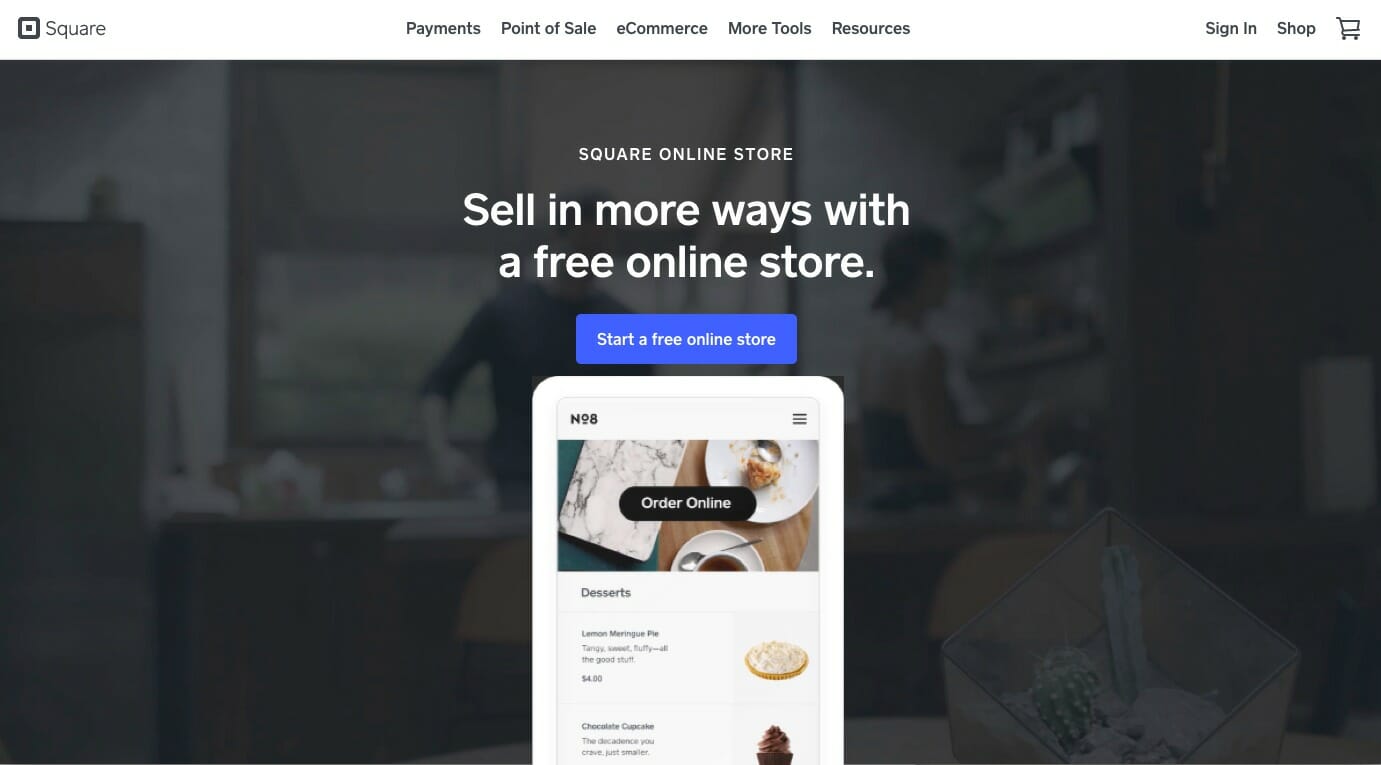
Not to be confused with Squarespace, Square Online Store is run by payment processor, Square (Weebly is, too). If you’re not familiar with Square, you should be. It’s one of the leading POS systems, and there’s a good chance you’ve paid through Square whether you realized it or not.
Unsurprisingly, Square Online Store’s integration with the POS system is its defining feature. While it’s not the only tool that offers this functionality, there is a benefit to having all your ecommerce systems built on the same platform.
Since Square Online Store is so inextricably tied to its in-person POS system, the website builder is best suited for businesses that do most of their sales in brick-and-mortar stores. For example, Square Online Store works great for restaurants looking to take online orders or stores that want to allow customers to place orders online and then pick them up in-store.
Plus, Square Online Store is very reasonably priced, with plans starting at $0/month. The most expensive plan is just $72/month, which is only slightly more than Shopify’s mid-tier plan. However, sellers will have to pay a transaction fee of 2.9% of each sale plus 30 cents. If you choose the highest-tier plan, that fee is reduced to 2.6% of each sale plus 30 cents.
Square Online Store is a good option for businesses that are primarily focused on in-person sales, but there are better options out there for online-only stores.
- Free: $0/month (+ 2.9% + 30 cents per transaction)
- Professional: $12/month (+ 2.9% + 30 cents per transaction)
- Performance: $26/month (+ 2.9% + 30 cents per transaction)
- Premium: $72/month (+ 2.6% + 30 cents per transaction)
You may also like:
- How to Keep Your E-commerce Site Secure Against Cyber Threats in 2023
- E-commerce Advertising Strategy: How We Doubled PPC Sales for ThinSlim Foods (with a 3X+ ROAS)
- How to Create an E-commerce Website Step by Step
What to Look for in an E-commerce Website Builder
It shouldn’t come as a surprise that this list of eight platforms is just the tip of the iceberg. There are tons of other ecommerce website builders out there for you to explore. We think that the ones we covered are the best on the market, but it’s entirely possible we missed a hidden treasure.
If the ecommerce platform you’re most interested in isn’t on this list or you simply don’t click with any of the ones we reviewed, here are the questions and criteria that you should be using to evaluate tools that you come across on your own.
Where are you as a business and what are your priorities?
Before you even start to look at ecommerce platforms, you need to look inward. While that may not require a full-blown meditation retreat (but hey, maybe it will), you will need to clarify why you want to move into ecommerce in the first place.
For example, are you an artist looking to sell a few of your paintings online? Or are you running an enterprise-sized business and want to grow your online presence? Alternatively, do you have a brick-and-mortar store and would like to give your customers the option of ordering online, too?
Each of those questions (or, rather, your answers to them) lends itself to a totally different ecommerce platform (artists will enjoy BigCartel, enterprises will gravitate towards BigCommerce and 3DCart, brick-and-mortar stores may find Square Online Store is the best fit).
The question is never really “What’s the best e-commerce website builder?” but rather, “What’s the best e-commerce website builder for me?”
What features are absolutely essential?
No two businesses are the same, and that means that what one company may consider an essential feature may be completely useless to another. When evaluating website builders, figure out whether there are any features you absolutely cannot do without.
For example, if you sell subscription-based products, you’ll need to find a platform that supports that. Similarly, if you simply can’t live without a drag-and-drop builder, make sure you choose one that offers that as a feature.
How easy is it to use?
Some ecommerce platforms are designed for total beginners while others are geared towards more advanced users. It’s important to consider whether your skill level matches up with the platform’s target user base.
For example, 3DCart will likely be overly complex for a complete beginner, while a very simple platform like BigCartel will probably end up being too simple and restricting for an advanced seller. Ease of use is relative, so it’s a good idea to give a few website builders a spin with a free trial and see which you find is the easiest to work with. You may find that you really click with Shopify but find Squarespace tricky or vice versa.
What are its design capabilities?
Website builders can largely be broken up into two separate camps: those that have drag-and-drop website builders and those that do not. If you want to work with a drag-and-drop builder, you’ve already narrowed your search. Similarly, if you’d prefer a CMS, then your choices are also limited.
If design is a top priority, you’ll also want to only look at website builders that offer a wide selection of templates to choose from.
How much does it cost?
This one should be obvious, but it’s worth mentioning. If you find the perfect website builder but it costs more than you have budgeted, it’s not the perfect website builder. Staying on budget is part of business 101, so don’t go breaking the bank thinking that spending some extra cash on a different platform is necessary to your store’s success — it’s not. All the platforms we’ve mentioned here are quite capable, and you really can’t go wrong with any of them.
More best-of posts:



